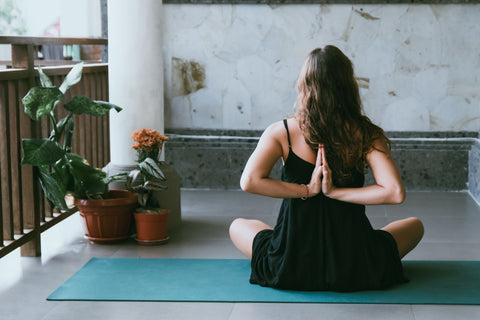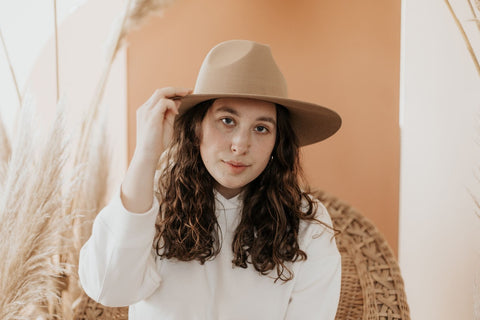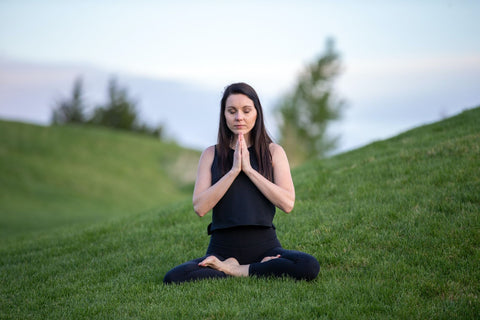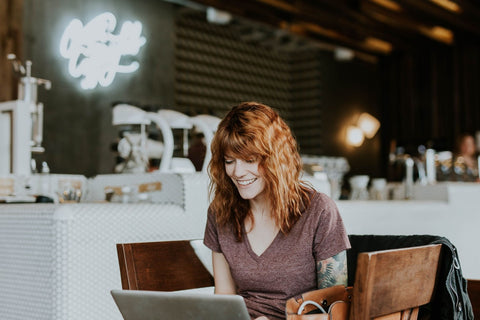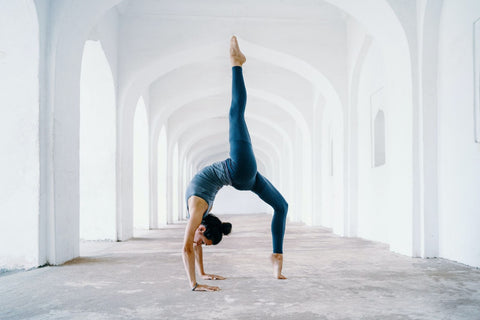
Whether you’re practicing yoga at home or in a studio, it’s vital to take the appropriate safety precautions to ensure that you are not doing more harm than good to your body. Of course, practicing yoga offers a wide range of health benefits, which makes it even more important to participate in the practice safely.
We don’t blame you for wanting to drop down into a pose as often as possible, whether you’re in your living room or at your favorite studio. To ensure you can do so with caution no matter what the setting, keep reading to learn how to do yoga inversions at home safely in order to reap the benefits of the sport and to enjoy practicing it all at the same time!
What are Yoga Inversions?

Before we learn how to safely perform inversions at home, let’s delve into what yoga inversions actually are. The idea of a yoga inversion is quite simple --it’s any pose where you are upside down. These can be as straightforward and simple as the Downward Dog pose to something as complex and challenging as a headstand.
Practicing inversions has physical, mental, and emotional benefits. First, they work to strengthen your upper body, from your core to your shoulders and everything in between. These poses are also energizing and simultaneously calming, regulating your breathing and heart rate, making you feel more centered overall. Finally, inversions are effective in improving circulation as well as the flow of lymph, which is denoted as a fluid that helps to remove toxins from the body.
The Risks Associated with Performing Yoga Inversions at Home

Inversions require strength, flexibility, and confidence in order to be successfully practiced. Because these poses are more in depth, there are more serious safety risks associated with practicing them, especially if you are doing so at home without the supervision of an instructor.
First, yoga inversions done incorrectly can pose a risk to your spine. The way that our spines are designed, the vertebrae are large at the bottom and then progressively become smaller the closer they get to our heads. As we stand, the spine works with other parts of our bodies, such as the pelvis, femurs, and so on, in order to easily and freely transfer energy up and down our spine.
However, when we invert our bodies into an upside-down position, it puts our spine in the opposite direction than how it is naturally. That means that the vertebrae are now stacked in a small to large position, dictating that the weight-bearing responsibility is placed upon the smaller scapulae, arms, hands, and surrounding area. Because this is an unnatural way for the spine to be situated and also because the top part of our bodies are not used to enduring such weight, it is not a surprise that it could cause injuries if the participant is not careful.
Along with the risk of causing stress on your spine, those practicing inversions also run the obvious risk of falling in a way that causes stress or trauma to their bodies. This could cause anything from a mild to severe injury, so it’s definitely something to watch out for. Finally, anyone with high blood pressure, a heart condition, eye problems, head, neck, shoulder, or wrists injuries, or anyone who is pregnant should consult a doctor before performing yoga inversions.
Yoga Inversion Safety at Home

Let’s delve into some safety tips to help you confidently perform yoga inversions from the comfort of your own home.
Work on your balance
It goes without saying that standing on your head requires balance, so in order to feel confident in your home yoga inversions, you should work on this skill. Women’s Health noted that one easy and effective way to improve your balance is to do core exercises such as sit ups or to work with a balance board. Their article also suggested doing one-legged exercises such as one-legged lunges or deadlifts in order to step up your balance game.

Learn to fall
While this may seem intimidating at first, learning to fall is a great way to ensure that you can safely practice yoga inversions at home. It probably feels natural to resist falling, but learning to fall the right way while doing complex poses such as a headstand will ensure that you don’t get hurt in the process. The best thing you can do is “embrace the fall” and accept it is all a part of the process when it comes to gaining confidence and skill in completing inversions.
Believe it or not, you can have a “strategy” when it comes to falling, which will mitigate the risk of the fall being a harmful shock to your body. First, you must always stay limber and loose when falling to disperse the energy throughout your body to reduce it’s overall impact. Next, you should always try to tuck your neck when you can, falling with your palms open and with a rounded back. Bend your knees and roll out of the pose as you come down. When tucking your neck is not possible, the next best option is to bend your knees and let your body fall into Bridge Pose with your head resting on the ground.
Practice beginner yoga inversions first
Even if you feel good about completing handstands in the presence of your yoga instructor, taking it slow when you start practicing these at home could help mitigate the risk of an injury. Begin with simpler inversions such as Dolphin Pose, a Wall T-Stand, or Supported Shoulderstand, moving on to more complex inversions once you’re feeling confident in the simpler ones.

Use the wall
If you’re not completely confident doing an inversion at home on your own, Popsugar suggests using the wall to help balance. To do take advantage of this tip, keep your head eight inches away from the wall, placing your feet on it for balance as needed. When you feel adequately balanced, you can remove your feet, all while knowing it’s behind you as an insurance policy if needed. You can also remove your feet one at a time as you are getting warmed up and gaining flexibility and strength.
Don’t forget to breathe
Just like with any other yoga pose, breathing is a vital part of correctly and effectively practicing inversions. When you hold your breath as you are upside down, it deprives your muscles of the oxygen they need to stay in the pose. A lack of oxygen will cause muscles to tense up, thus not working to their full capability. Furthermore, practicing good breathing habits will help you to stay focused and calm as the blood is rushing to your head during these upside-down poses.

Use the buddy system
Even if you don’t have your trusted yoga instructor with you, you can still do inversions at home with a friend to ensure complete safety. Take turns watching each other’s work, even critiquing one another while you’re at it. Plus, it’ll be more fun with a yoga-loving friend.
It is without a doubt that inversions are a challenging, rewarding, and exciting part of yoga. However, practicing them - especially in the comfort of your own home - does not come without risks that must be mitigated. Following these safety tips will give you the peace of mind that you’re practicing caution while you build your confidence in these tricky yet impressive poses!

